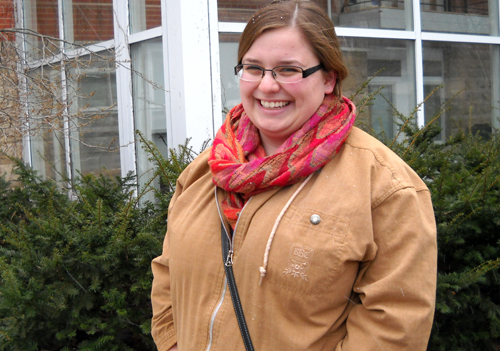
A month on a fishing boat? It wasn’t quite as relaxing or exotic as it might sound. The boat was a craft borrowed from a Guelph professor, and the fishing involved catching mostly unpalatable invertebrates around Georgian Bay in Lake Huron.
Still, Rachel Salt enjoyed her sampling field trip last August for her master’s degree in the School of Environmental Sciences. Along with Profs. Neil Rooney and Paul Sibley, she’s looking at food webs in lakes to learn more about human impacts over time.
Invasive species, development and climate change are among the threats to Georgian Bay, a complex, diverse ecosystem that is home to many species at risk.
She hopes to develop tools to help assess human impacts and protect natural ecosystems. She’s already found evidence that we need to pay attention to slow-acting, cumulative changes caused by humans in ecosystems.
“Small anthropogenic stresses accumulate over time,” says Salt.
She studied eight sites around Georgian Bay with varying human impacts. Besides nearby farming, the area attracts cottagers and water sports enthusiasts.
The bay also has cultural significance for First Nations, notably the Saugeen Ojibway First Nation, who are partners in her research.
Last summer and fall, Salt collected organisms from around the bay to gauge how many different species live in deep and shallow habitats.
She then analyzed tissue samples from those organisms, using stable isotope analysis. Relative amounts of carbon and nitrogen in tissue can tell biologists where different species feed and their place in the food web.
By learning about food web structure, Salt intends to develop diagnostic tools to assess human impacts on aquatic ecosystems. More simple or more complex food webs can point to more or less stable ecosystems, with varied vulnerability to human impacts.
Her work might also help pinpoint the effects of invasive species, such as the goby. “This would act as a diagnostic tool” for assessing ecosystem health and anthropogenic impacts, she says.
Salt says it’s too early for her to pronounce judgment on Georgian Bay. She has collected data from eight locations but has analyzed only three sites so far, including Wiarton and Owen Sound. She hopes to return this summer for more sampling.
You need not fish for creatures in the bay to get a sense of changes in the area. On aerial photographs from 1958 and 2008, Salt points out how the shoreline has receded and how farms, homes and roads have replaced much of the earlier forest.
These stressors are not all equal, she says. Farming affects the entire watershed. Runoff from urban development might affect only the nearby water. Put them together, and they might have a larger impact on the ecosystem than a single major development such as a hydro dam or a nuclear power plant.
Besides looking at food webs, she will use DNA barcoding to identify organisms and learn more about the diversity of living things in the bay.
For her biomonitoring project, Salt also works with a group called Georgian Bay Forever.
Recalling occasional childhood vacations there, she says, “I’ve always loved that area.”
She says her work might be adapted for other areas around the Great Lakes, and even in food webs based on land.
That might extend to the harbour in Hamilton, Ont., where Salt grew up.
“I think Hamilton Harbour is beautiful,” she says, referring to the mix of natural and industrial landscapes around the city. Moving to Grimsby for grade school, she saw a similar land use conflict play out as development tussled with farming.
She says her parents encouraged her to ask questions and look at the big picture. “I’ve always been interested in natural history and environmental sciences.”
During her undergrad in environmental sciences, she worked with integrative biology professor Kevin McCann on invasive species and food web structure. “Guelph has an amazing environmental science program,” she says.